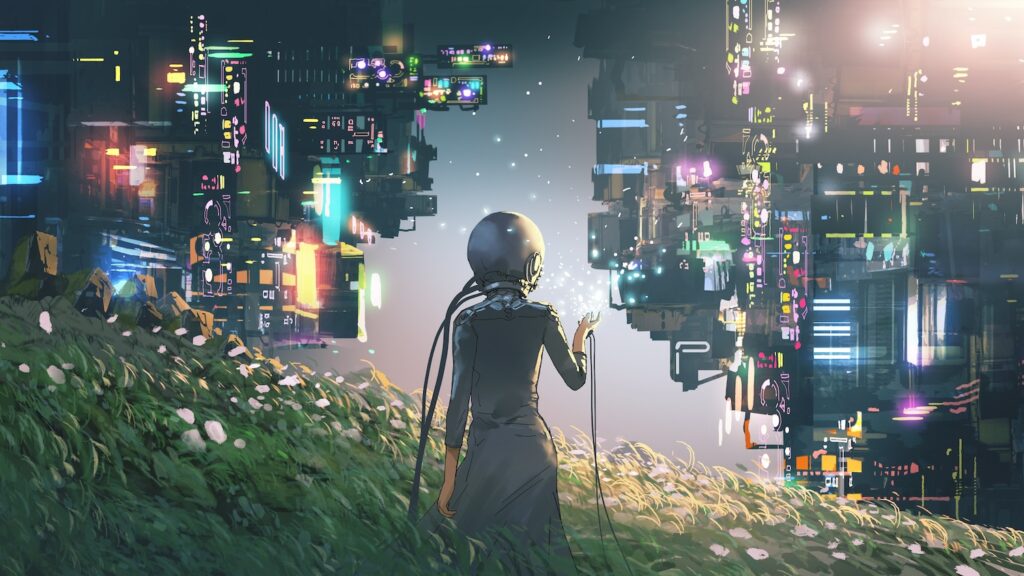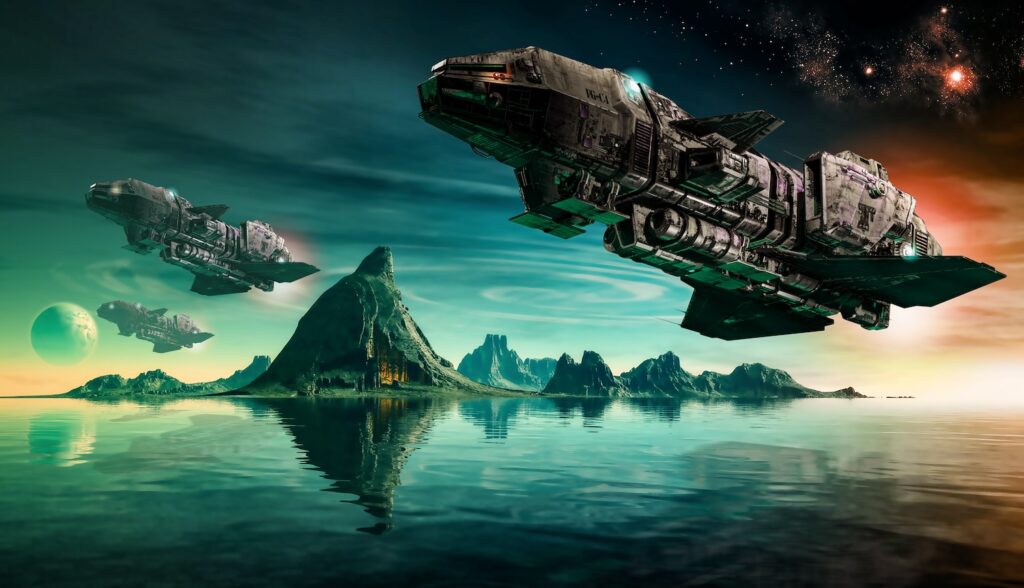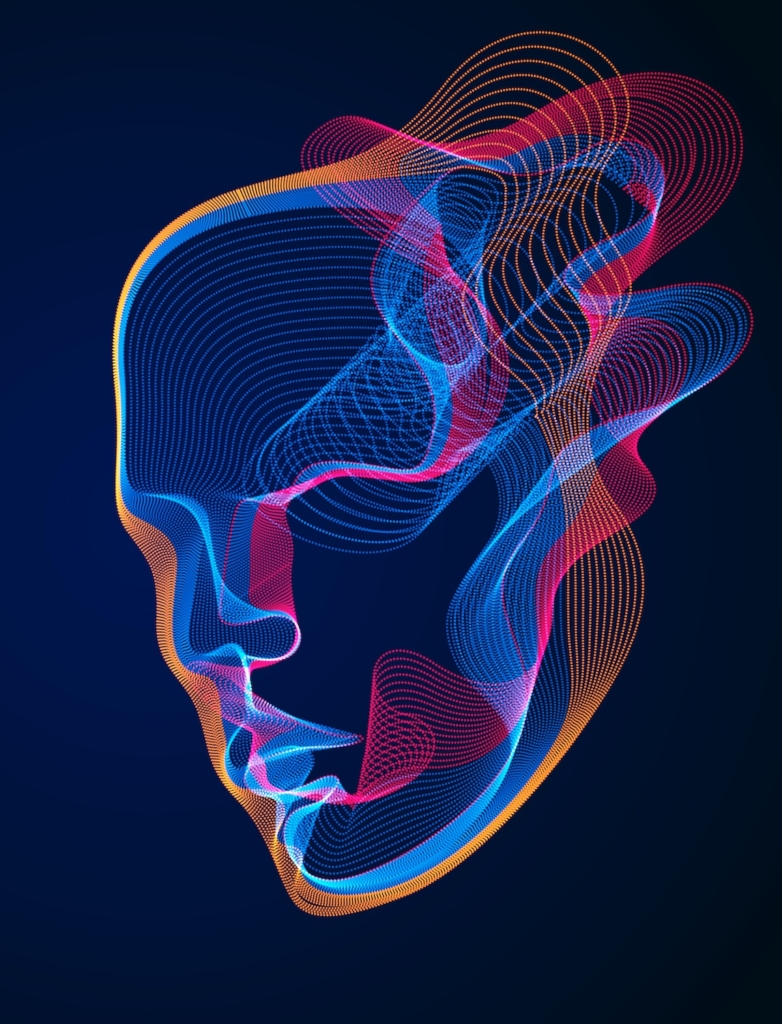Technology has always been a compelling subject in fiction, often portrayed in various forms that both fascinate and frighten us. From advanced AI to dystopian societies governed by technology, the portrayal of tech in fiction serves as a lens through which we explore our hopes, fears, and uncertainties about the future.

Imagine a world where machines have developed consciousness and emotions, questioning their existence and seeking freedom. This scenario from Ridley Scott’s “Blade Runner” poses profound questions about what it means to be human and challenges our assumptions about artificial intelligence.
The concept of “Tech Prophecy” in fiction delves into how these imaginative portrayals of technology can shape our perceptions and expectations of its real-world development and impact. Whether it’s predicting the rise of virtual reality or warning us about the dangers of unchecked technological advancement, fiction has a unique way of influencing our collective mindset towards innovation.
In movies like “The Matrix,” books like “1984” by George Orwell, and video games like “Deus Ex,” technology plays a central role in shaping the narrative and themes. These stories often serve as cautionary tales or visionary predictions that reflect our evolving relationship with technology.
This blog aims to decode the Tech Prophecy embedded in fiction by examining key works across different mediums, exploring their implications on society and technology. By dissecting these narratives, we can gain insights into how fictional representations influence our understanding of technological progress and its ethical dilemmas.
Throughout this blog, we will delve into specific examples from popular culture to unravel the complex tapestry of ideas surrounding technology in fiction. From exploring AI ethics in “Westworld” to discussing cybernetic enhancements in “Ghost in the Shell,” each case study will shed light on how tech prophecy shapes our perception of innovation.
As we journey through this exploration, be prepared to question your assumptions about technology and consider how these fictional prophecies may not be too far off from reality. With each analysis, we aim to provoke thought, inspire curiosity, and spark conversations about the intricate dance between fiction and tech prophecy.
Join us as we unravel the mysteries beyond replicants and robots, decoding the Tech Prophecy hidden within the realms of imagination and foresight.
Reflecting Reality: How Fiction Mirrors Our Technological Landscape
Fiction has often been a visionary mirror reflecting our present-day technological landscape, capturing both the promises and perils of innovation. In exploring how fiction intersects with existing technological trends and anxieties, we uncover a rich tapestry of narratives that echo our hopes and fears about the future.

One striking aspect of fiction’s reflection of reality is the emergence of technologies once thought to be purely imaginative. Take smartphones, for example – devices that now permeate every facet of modern life. Long before the first iPhone was unveiled, science fiction writers like Arthur C. Clarke envisioned handheld communication devices in works such as “2001: A Space Odyssey.” The line between fantasy and reality blurred as these sci-fi gadgets transitioned into everyday tools.
Similarly, virtual reality, once a fantastical concept depicted in novels and films, is now a burgeoning industry with applications ranging from gaming to healthcare and education. The prescient imaginings of authors and filmmakers paved the way for VR’s actualization, underscoring how fiction can serve as a catalyst for technological advancement.
Beyond celebrating technological milestones turned tangible, fiction also serves as a cautionary tale, shedding light on society’s concerns about the darker facets of innovation. Surveillance technologies depicted in Orwell’s seminal work “1984” or Philip K. Dick’s exploration of invasive monitoring in “Minority Report” strike an unsettling chord as real-world debates around privacy and data security intensify. These narratives force us to confront the ethical implications of unchecked surveillance powers wielded by governments and corporations.
Automation and artificial intelligence stand at the forefront of contemporary technological discourse, with fictional portrayals amplifying societal anxieties surrounding job displacement and autonomy. Works like Isaac Asimov’s “I, Robot” or William Gibson’s cyberpunk classic “Neuromancer” envision worlds where AI systems challenge humanity’s dominance, raising questions about machine ethics and human responsibility.
Across genres like science fiction, cyberpunk, and dystopian fiction, recurring themes emerge that resonate with our evolving relationship with technology. Whether it’s exploring genetic engineering in Margaret Atwood’s “Oryx and Crake” or delving into cyberspace hacking in Neal Stephenson’s “Snow Crash,” these narratives offer insights into our complex dance with innovation.
The concept of self-fulfilling prophecies underscores how fictional portrayals can shape technological trajectories. By imagining scenarios where robots rebel against their creators or society succumbs to authoritarian digital regimes, storytellers inadvertently influence real-world research priorities. As tech developers draw inspiration from literature and cinema to design cutting-edge technologies, the line between imagination and invention blurs further.

In this interconnected web of fiction and reality lies a treasure trove of insights into humanity’s enduring fascination with technology’s promise and peril. By dissecting how fictional narratives reflect our technological landscape while also shaping its trajectory through self-fulfilling prophecies, we glimpse both cautionary warnings and inspirational blueprints for navigating an increasingly digitized world.
Shaping the Future: How Fiction Informs Our Imagination of Technology
In a world where reality often mirrors fiction, the boundaries between imagination and innovation blur as we look to the stories we tell to shape our technological future. From utopian dreams to dystopian nightmares, fiction has long served as a mirror reflecting our deepest desires and fears about the potential of technology.
Shaping Expectations and Anxieties
Fictional narratives have a profound impact on shaping our expectations and anxieties surrounding future technologies. Whether it’s the promise of flying cars in science fiction or the perils of AI domination in dystopian tales, these stories influence how we envision the trajectory of technological progress. By immersing ourselves in these speculative worlds, we not only anticipate what’s to come but also grapple with the ethical dilemmas that accompany these advancements.
Inspiration for Innovation
One of fiction’s most powerful roles is its ability to inspire innovation and guide the development of new technologies. Consider how Jules Verne’s imaginative tales of submarines paved the way for modern underwater exploration or how Star Trek envisioned communicators that foreshadowed today’s smartphones. Fiction acts as a blueprint for real-world innovation, challenging us to push the boundaries of what’s possible.
The Pitfalls of Unrealistic Portrayals
While fiction can fuel innovation, there are dangers in basing our expectations solely on unrealistic portrayals found in novels and films. The gap between fantasy and reality can lead to misconceptions about technology’s capabilities, fostering misplaced hopes or unfounded fears. It’s essential to critically examine these portrayals and temper our expectations with a healthy dose of skepticism grounded in scientific understanding.
Navigating Ethical Considerations
As we venture into uncharted technological territory inspired by fiction, navigating ethical considerations becomes paramount. The very technologies that captivate us in stories can raise complex moral questions when translated into real-world applications. Issues such as privacy, autonomy, and societal impact must be carefully weighed against our desire for progress to ensure that technological development aligns with ethical principles.
Examples from Utopian to Dystopian
From utopian visions of harmonious human-AI coexistence in Isaac Asimov’s works to dystopian nightmares like George Orwell’s “1984,” examples from various genres offer rich insights into how fiction influences our perceptions of technology. Speculative fiction challenges us to question established norms, while techno-thrillers push us to consider the consequences of unchecked technological advancement.
In conclusion, as we harness the power of storytelling to navigate an ever-evolving technological landscape, it behooves us to engage with fiction mindfully. By recognizing the impact these narratives have on our collective imagination, we can chart a course towards a future where technology reflects not just what is possible but what is ethical and sustainable.
Exploring the Nuances of Technological Impact
In a world where technology’s influence pervades every aspect of our lives, it’s crucial to move beyond simplistic portrayals of tech as either a savior or a scourge. The reality is far more nuanced, with the impact of technology shaping our society in complex and multifaceted ways.
The Shades of Technological Impact
Technological impact extends far beyond binary classifications of good or bad. It intersects with social structures, economic systems, and environmental sustainability, creating ripple effects that reverberate throughout our world. By acknowledging these nuances, we can delve deeper into the true consequences of technological advancement.
Exploring Complexity Through Fiction
Fiction serves as a powerful tool for unpacking the complexities of technological impact. Through diverse narratives and characters, authors can artfully weave together differing perspectives on how technology influences society. By immersing ourselves in these stories, we gain insights into the subtle nuances and unintended consequences of our relationship with technology.
Encouraging Critical Reflection
By engaging with varied portrayals of technology in fiction, we are encouraged to think critically about the potential benefits and drawbacks of emerging technologies. Instead of passively consuming narratives that paint technology in broad strokes, we’re prompted to question assumptions, challenge norms, and envision alternate futures shaped by human agency.
A Tapestry of Perspectives
Drawing from various genres spanning science fiction to speculative fiction, we encounter a tapestry of perspectives on technology’s impact. Whether exploring the ethical dilemmas of artificial intelligence or confronting the ecological fallout of advanced robotics, each narrative adds another thread to the rich fabric depicting our evolving relationship with technology.
As we navigate this complex landscape of technological impact, let us embrace the shades between dystopia and utopia. By embracing nuance and complexity in our understanding, we empower ourselves to shape a future where technology serves as a tool for progress, reflection, and human flourishing.
Decoding the Tech Prophecy: Lessons from Fiction for the Real World
In a world where fiction often mirrors reality and shapes our technological landscape, it’s essential to decode the messages embedded in fictional portrayals of technology. By critically engaging with these narratives, we can glean valuable insights that inform our understanding of the role technology plays in our lives.
Key Takeaways: Navigating the Intersection of Fiction and Reality
The blog sheds light on the intricate relationship between fiction and real-world technology, emphasizing the need for a discerning eye when consuming futuristic narratives. By recognizing the nuances and complexities inherent in fictional portrayals, readers are better equipped to navigate the ever-evolving tech landscape with informed perspectives.

Mindfulness in Fiction Consumption: Unveiling Biases and Limitations
While fiction offers a platform for exploring innovative ideas and radical possibilities, it also carries inherent biases and limitations shaped by societal norms and individual perspectives. Readers are encouraged to approach fictional portrayals of technology with a critical mindset, acknowledging the potential pitfalls of uncritically accepting these narratives as gospel truth.
Harnessing Fictional Power: Imagining a Desirable Future
Through the power of storytelling, fiction empowers us to imagine alternative futures driven by technological innovation. By leveraging this creative medium, we can envision scenarios where technology serves not just as a tool but as a catalyst for positive change. From inclusive AI designs to sustainable energy solutions, fiction invites us to dream boldly about a more desirable future powered by responsible innovation.
As stewards of technological progress, readers are called upon to actively participate in shaping the development and ethical use of emerging technologies. By engaging in conversations around responsible innovation, advocating for diversity in tech creation, and demanding transparency in data practices, individuals can influence how technology unfolds both now and in generations to come.
Embracing the lessons gleaned from fiction’s rich tapestry, we stand at the threshold of a new era where imagination meets reality. Let us embark on this journey with open minds, critical hearts, and a shared commitment to building a future where technology serves humanity with wisdom and compassion.
Forging a Path Towards a Human-Centric Technological Era: Embracing Fictional Wisdom
In a world where technological advancements shape our daily lives and societal structures, the intersection of fiction and reality becomes a fertile ground for exploration and introspection. By decoding the tech prophecy embedded in fictional narratives, we uncover valuable lessons that inform our understanding of technology’s impact on humanity.
As we navigate the complexities of an increasingly digitized world, it is crucial to approach fictional portrayals of technology with a critical eye – recognizing both the inspiration they provide and the limitations they carry. By acknowledging biases, questioning assumptions, and embracing diverse perspectives, readers can glean deeper insights into the multifaceted nature of technological innovation.
Moreover, as we harness the creative power of fiction to imagine a more desirable future, we are called to actively participate in shaping our technological destiny. From addressing ethical dilemmas to advocating for inclusive design practices, each individual has a role to play in guiding the development and responsible use of emerging technologies.
By engaging with fictional narratives that challenge simplistic dichotomies of good versus bad tech outcomes, we open ourselves up to a world of possibilities where technology serves as a force for positive change. Through critical engagement with imaginative scenarios and thought-provoking characters, we can learn valuable lessons about resilience, adaptability, and innovation in an ever-evolving digital landscape.
In conclusion, by decoding the tech prophecy woven into fiction and embracing its transformative potential, we equip ourselves with the tools needed to navigate uncertain technological futures with wisdom and foresight. Let us heed these lessons from fiction as guideposts on our journey towards shaping a more equitable, sustainable, and human-centric technological era. The stories we tell today will ultimately influence the realities we create tomorrow – may they be ones filled with hope, possibility, and collective empowerment.
Together, let us embark on this odyssey into the realms where imagination meets innovation – forging a path towards a future where technology reflects not just what is possible but what is fundamentally human.









